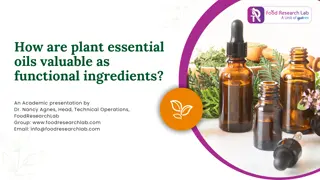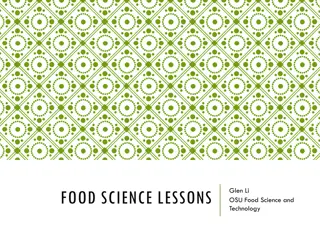Understanding the Properties and Functions of Ingredients in Food Preparation
Explore the various types of ingredients in food preparation, including primary, secondary, components, and composites. Learn about the properties and functions of ingredients such as aerating, binding, browning, emulsifying, flavoring, moistening, preserving, setting, stabilizing, sweetening, thickening, and volumizing. Discover the significance of different food properties and how they affect the texture, taste, and appearance of dishes.
Download Presentation

Please find below an Image/Link to download the presentation.
The content on the website is provided AS IS for your information and personal use only. It may not be sold, licensed, or shared on other websites without obtaining consent from the author. Download presentation by click this link. If you encounter any issues during the download, it is possible that the publisher has removed the file from their server.
E N D
Presentation Transcript
Properties and functions of ingredients Properties and functions of ingredients Primary ingredients: Raw foods that have received little or no processing i.e. fresh fruit or vegetables Secondary ingredients: Foods that have received more complex processing which makes them into composites or products i.e. a pasta sauce, pastry case. Components : Individual ingredients which make up a product i.e. flour, fat and water = pastry. Composites: Foods that have had some processing but are still not the final product i.e. shortcrust pastry that still need to be turned into a pie.
Properties and functions of ingredients Properties and functions of ingredients Food properties Different foods have different working properties when treated in certain ways or combined with other foods. The table lists the working properties you need to know about. Aerating makes a mixture lighter. Fats, eggs and sugar are used for aerating. Binding helps to stick ingredients together. Fats, eggs, cereals and flour are used for binding, eg egg is used to bind together a biscuit mixture. Browning adds a layer of colour to the mixture. Fats, eggs, cereals, sugar, milk, flour and oil are used for browning, eg when heated, egg glaze or sugar turns brown adding to the appearance of the food. Emulsifying uses eggs to help mix two liquids that would normally stay separate, such as water and oil. Flavouring helps to make something taste better, by adding fats, eggs, pulses, fruit, sugar, milk or oil. Moistening helps to remove the dryness from foods. Fats, eggs, fruit, sugar, milk or oil are used for moistening. Preserving helps food to last longer, through freezing, canning, jam-making pickling etc. Foodstuffs used in preserving are fats, sugar and oil. Setting uses eggs to make foods firm. Shortening is the use of oils and fats such as butter and lard, to reduce the development of gluten in pastry, which makes the pastry dough less stretchy. The fat coats the flour and prevents too much water from being absorbed during the mixing and produces a crumbly, short-textured, melt-in-the-mouth effect. Stabilising helps food to keep its structure. Eggs and flour are used for stabilising. Sweetening improves the flavour of certain foods by adding sugar or fruit, eg sugar will help to soften the sharp taste of grapefruit. Thickening is the use of eggs, pulses, cereals and fruit to thicken liquids such as milk. (Usually heat is applied, as in the making of egg custard). Volumising is the use of eggs to increase the volume or amount of space occupied by a substance. For example egg whites will trap air when whisked/beaten and will produce a mass of bubbles called a 'foam' - a process used in the making of meringues. As you can see from the chart, most of these working properties can be found in many different foods:
Properties and functions of ingredients Properties and functions of ingredients Smart Starches These are starches that have been changed by the manufacturers to reach differently in different situations and are called MODIFIED STARCHES STARCH These are food products obtained from cereals, root vegetables and fruit. They can be used to thicken liquids. When heated the starch grains bust and absorb the liquid causing gelatinisation. Pregelatinised allows them to thicken instantly instant custard, pot noodles 1. 2. Starch particles do not dissolve in liquid instead they form a suspension Stirring or agitating the liquid keeps the particles suspended. If the suspension is not stirred the particles form to the bottom forming lumps When the liquid reaches 60 C the starch grains begin to absorb the liquid At 80 C the particles break open and release starch making the mixture thick and viscose, this is called gelatinisation. Gelatinisation is complete when the liquid reaches 100 C. The thickened liquid now forms a gel. On cooling the gel solidifies. No sineresis allows starch product to be reheated easily used in ready meals with sauces e.g. lasagne 3. 4. 5. Thickening in low calorie products where less starch is used or more acid required salad dressings 6. Fat replacement currently under development is a starch that could replace some of the fat in low fat dishes like biscuits and cakes. The reheating quality of starch can be poor as they often separate leaving a thin liquid behind. (SINERESIS)
Properties and functions of ingredients Properties and functions of ingredients Fats and oils Animal pigs, cows, sheep Vegetable wheat, barley, oats, seeds, olives, beans, some fruit (avocado) Fish trout, mackerel, salmon, herring Function of fats: What it does Example .. Fat in biscuits, cakes, bread. Melted on vegetables, Olive oil drizzled on pasta Butter, margarine on bread and scones Butter and lard help to preserve p t s by sealing them Shortbread, cakes and pastries have a crumbly texture because the flour particles are coated in fat In cake mixtures, butter and margarine help to trap air when creamed with sugar The addition of fat to baked products means that they stay moist for longer. Types Fat is solid at room temperature soft margarine, butter, dripping, block margarine, low fat spread, suet. Oil is liquid at room temperature cream, sesame seed oil, fish oils, olive oil, vegetable oil, sunflower oil, rape-seed oil. Saturated Fats mainly from animal sources, can increase blood cholesterol that leads to heart disease. Polyunsaturated mainly from plant sources Adds flavour Makes food moist Seals Shortens/changes texture Low fat products Too much can cause obesity, too much saturated can result in heart disease. Using low fat products can help reduce these risks. Look for low fat or fat reduced on the packaging. Aerates Extends the shelf life
Properties and functions of ingredients Properties and functions of ingredients Eggs Mostly from chickens but all bird eggs can be eaten. Sugar Sugar cane and sugar beet are processed to produce different types of sugar -molasses, granulated, caster, dark brown, soft brown, muscavado, icing, demerara, cubes. Functions of Eggs Aeration Whisking stretches the protein and adds air bubbles. The air bubbles form a foam which partially coagulates. Used in sponge cakes, meringues and mousses Emulsification When oil and another liquid are forced together they emulsify. The addition of egg yolk (lecithin) stabalises the emulsification. mayonnaise. Coagulation Eggs set and eventually go solid when heated. The egg white sets at 60 C, the yolk at 70 C. Used to set mixture like quiche, custard and lemon curd. Other uses Garnish Chopped or sliced to decorate savoury products. Glaze Any part of the egg can be used to brush over a baked product to make it shine, particularly pastry and bread. Functions of sugar Cakes, biscuits to add sweetness and colour, prevent drying out, give texture and volume. Jam to act as a preservative, help set the fruit. Bread to speed up fermentation of the yeast Ice cream to lower freezing point, add texture and volume Creamed mixtures (cakes, biscuits) to lighten and help fat trap air. Plain looking foods to decorate Artificial sweeteners These are lower in calories but are mainly used to sweeten as they often fail to duplicate other functions. Hydrogenated sweeteners Sorbitol, Mannitol, Xylitol, Hydrogenated Glucose Syrup. Non-nutritive/intensive sweeteners Saccharine, Aspartame, Acesulfame, Thaumarin
Properties and functions of ingredients Properties and functions of ingredients Nutritional Content Sugar lactose, Vitamin B, Calcium, Fat, Phosphorus, Protein, Vitamin A. The amount of fat depends on the type of milk. Dairy products Milk All mammals produce milk but the main ones we drink are cows. Increasing amounts of goats milk are now being drunk by those with an intolerance to cows milk. Functions of milk To improve the nutritional value of a product add protein, fat. To add flavour. Primary processing: this takes the milk from the animal and treats it to make it safe to drink and use. Pasteurised- this make the milk safe to use as it destroys and harmful bacteria. Milk is heated to 72 C for 15 seconds then cooled rapidly to 10 C or below before being packaged. Homogenised after pasteurisation the milk is forced through tiny holes to mix in the cream. Sterilized after pasteurisation and homogenisation the milk is bottled, sealed and heated to 110 C for 30 mins. This alters the taste. Evaporated water is evaporated off to make it more concentrated. It is then homogenised and packed into cans before heating to 120 C for 10 mins. The taste is altered and the milk is slightly thicker. Dried drying removes the water, this allows it to keep for several months. The milk is sprayed into a hot chamber, the liquid evaporated leaving behind a fine powder. Skimmed this has all the cream removed so is low in fat. Semi-skimmed this has some of the fat removed UHT (Ultra Heat Treated) The milk is heated to 140 C for 1 second before being cooled quickly then packaged. This milk will keep for a longer time. Channel Island milk is from Jersey and Guernsey cows and is 5% higher in fat. Condensed Milk water is evaporated from the milk then sugar is added to preserve it and make it thicker. Secondary Processing Butter made by churning the cream. Function to improve flavour and moisture of a product. Cream extracted from the milk. The fat content depends on the type of cream. Double, single, whipping, clotted, cr me fra che, sour, sterilised. Function to add flavour and richness. Cheese This is a solid form of milk 33% each of fat, protein and water. The cheese depends on the kind of milk and bacteria used and the method of production. Function to add flavour, moisture and texture. Yogurt Made by adding a special bacteria to the milk which make it sourer and thickens the milk. Flavour and sugar can then be added. Function add flavour and texture but can reduce fat content. Effects of heating can change the way milk products react cheese melts and separated into protein and fat so should be heated slowly. - milk hold air as it boils, this is good when making the frothy topping for coffee cappuccino.























